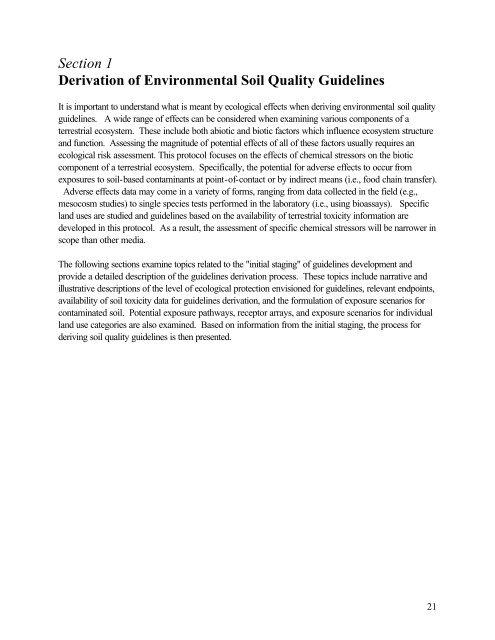Protocol for the Derivation of Environmental and Human ... - CCME
Protocol for the Derivation of Environmental and Human ... - CCME
Protocol for the Derivation of Environmental and Human ... - CCME
You also want an ePaper? Increase the reach of your titles
YUMPU automatically turns print PDFs into web optimized ePapers that Google loves.
Section 1<br />
<strong>Derivation</strong> <strong>of</strong> <strong>Environmental</strong> Soil Quality Guidelines<br />
It is important to underst<strong>and</strong> what is meant by ecological effects when deriving environmental soil quality<br />
guidelines. A wide range <strong>of</strong> effects can be considered when examining various components <strong>of</strong> a<br />
terrestrial ecosystem. These include both abiotic <strong>and</strong> biotic factors which influence ecosystem structure<br />
<strong>and</strong> function. Assessing <strong>the</strong> magnitude <strong>of</strong> potential effects <strong>of</strong> all <strong>of</strong> <strong>the</strong>se factors usually requires an<br />
ecological risk assessment. This protocol focuses on <strong>the</strong> effects <strong>of</strong> chemical stressors on <strong>the</strong> biotic<br />
component <strong>of</strong> a terrestrial ecosystem. Specifically, <strong>the</strong> potential <strong>for</strong> adverse effects to occur from<br />
exposures to soil-based contaminants at point-<strong>of</strong>-contact or by indirect means (i.e., food chain transfer).<br />
Adverse effects data may come in a variety <strong>of</strong> <strong>for</strong>ms, ranging from data collected in <strong>the</strong> field (e.g.,<br />
mesocosm studies) to single species tests per<strong>for</strong>med in <strong>the</strong> laboratory (i.e., using bioassays). Specific<br />
l<strong>and</strong> uses are studied <strong>and</strong> guidelines based on <strong>the</strong> availability <strong>of</strong> terrestrial toxicity in<strong>for</strong>mation are<br />
developed in this protocol. As a result, <strong>the</strong> assessment <strong>of</strong> specific chemical stressors will be narrower in<br />
scope than o<strong>the</strong>r media.<br />
The following sections examine topics related to <strong>the</strong> "initial staging" <strong>of</strong> guidelines development <strong>and</strong><br />
provide a detailed description <strong>of</strong> <strong>the</strong> guidelines derivation process. These topics include narrative <strong>and</strong><br />
illustrative descriptions <strong>of</strong> <strong>the</strong> level <strong>of</strong> ecological protection envisioned <strong>for</strong> guidelines, relevant endpoints,<br />
availability <strong>of</strong> soil toxicity data <strong>for</strong> guidelines derivation, <strong>and</strong> <strong>the</strong> <strong>for</strong>mulation <strong>of</strong> exposure scenarios <strong>for</strong><br />
contaminated soil. Potential exposure pathways, receptor arrays, <strong>and</strong> exposure scenarios <strong>for</strong> individual<br />
l<strong>and</strong> use categories are also examined. Based on in<strong>for</strong>mation from <strong>the</strong> initial staging, <strong>the</strong> process <strong>for</strong><br />
deriving soil quality guidelines is <strong>the</strong>n presented.<br />
21
















